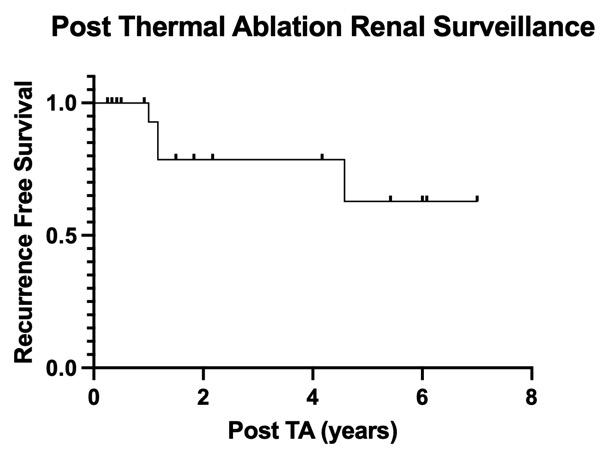Back
Introduction: Utilization of non-surgical modalities to manage local recurrence (LR) of renal mass after partial nephrectomy (PN) is paramount. Recurrence has been reported up 3.2% during the surveillance period. Repeat PN for an ipsilateral recurrence, while feasible, can be technically challenging with upwards of a 19.6% major perioperative complication rate. Percutaneous thermal ablation (PTA) for LR is a nephron-sparing procedure that is a viable option in this setting. In this study, we present our experience with LR of renal mass after PN to assess perioperative and oncologic outcomes.
Methods: We reviewed a retrospective case series of patients in two institutions who had LR after PN for RCC and were managed with PTA. LR was defined as enhancing renal mass ipsilateral to prior PN. The primary objectives were post-ablation recurrence free survival (RFS) and complication rate. A descriptive analysis was performed of the data collected. Kaplan-Meier survival analysis was performed to assess recurrence free survival after TA for LR.
Results: We identified 27 patients between 2012 and 2022 that were treated percutaneously with cryoablation (37%), radiofrequency ablation (33%) or microwave ablation (30%). The patients had a combined 34 tumors removed by PN, primarily T1a (70%) or T1b (15%), with clear cell (59%) or papillary (29%) subtype. There were positive surgical margins at PN in 33% of patients. LR occurred at median of 4 years after PN with a median size of 1.7 cm. Five tumors (17%) recurred at the PN site and the remainder were de novo tumors. Two patients (7%) developed perinephric hematoma immediately post-procedure that was managed conservatively (Clavien-Dindo Grade 1). Surveillance imaging was performed according to international management guidelines. Following PTA, there were 4 ipsilateral recurrences (13%) at a median of 14 months. One patient required repeat ablation for an ipsilateral tumor. RFS after PTA for LR was 93%, 79%, and 63% at 1 years, 2 years, and 5 years, respectively.
Conclusions: Our data demonstrate that local therapy with PTA for local recurrence after PN is safe and feasible. Further comparisons of local therapies for management of LR after partial nephrectomy may reinforce the use of PTA for small renal masses. SOURCE OF
Funding: None.

Moderated Poster Session
Session: MP47: Kidney Cancer: Localized: Surgical Therapy II
MP47-08: Percutaneous Thermal Ablation is Safe and Feasible for Ipsilateral Local Recurrence of Disease After Partial Nephrectomy for Renal Cell Carcinoma
Saturday, April 29, 2023
3:30 PM – 5:30 PM CST
Location: S504
- JR
Poster Presenter(s)
Introduction: Utilization of non-surgical modalities to manage local recurrence (LR) of renal mass after partial nephrectomy (PN) is paramount. Recurrence has been reported up 3.2% during the surveillance period. Repeat PN for an ipsilateral recurrence, while feasible, can be technically challenging with upwards of a 19.6% major perioperative complication rate. Percutaneous thermal ablation (PTA) for LR is a nephron-sparing procedure that is a viable option in this setting. In this study, we present our experience with LR of renal mass after PN to assess perioperative and oncologic outcomes.
Methods: We reviewed a retrospective case series of patients in two institutions who had LR after PN for RCC and were managed with PTA. LR was defined as enhancing renal mass ipsilateral to prior PN. The primary objectives were post-ablation recurrence free survival (RFS) and complication rate. A descriptive analysis was performed of the data collected. Kaplan-Meier survival analysis was performed to assess recurrence free survival after TA for LR.
Results: We identified 27 patients between 2012 and 2022 that were treated percutaneously with cryoablation (37%), radiofrequency ablation (33%) or microwave ablation (30%). The patients had a combined 34 tumors removed by PN, primarily T1a (70%) or T1b (15%), with clear cell (59%) or papillary (29%) subtype. There were positive surgical margins at PN in 33% of patients. LR occurred at median of 4 years after PN with a median size of 1.7 cm. Five tumors (17%) recurred at the PN site and the remainder were de novo tumors. Two patients (7%) developed perinephric hematoma immediately post-procedure that was managed conservatively (Clavien-Dindo Grade 1). Surveillance imaging was performed according to international management guidelines. Following PTA, there were 4 ipsilateral recurrences (13%) at a median of 14 months. One patient required repeat ablation for an ipsilateral tumor. RFS after PTA for LR was 93%, 79%, and 63% at 1 years, 2 years, and 5 years, respectively.
Conclusions: Our data demonstrate that local therapy with PTA for local recurrence after PN is safe and feasible. Further comparisons of local therapies for management of LR after partial nephrectomy may reinforce the use of PTA for small renal masses. SOURCE OF
Funding: None.

